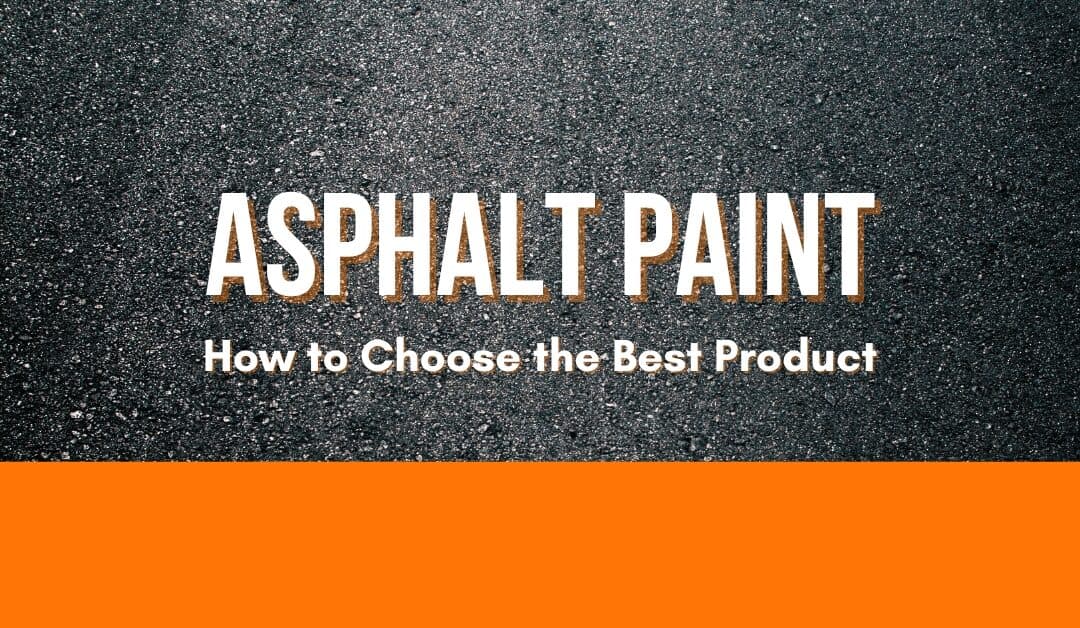If you’re ready to paint lines on a parking lot, there are a million types of paint to choose from. How do you know which is best? Keep reading to examine the types of asphalt paint and which are most durable for your driveway or parking lot.
Acrylic, Oil-Based, and Solvent Based Are Not the Same Paints
Solvent-based, oil-based, and acrylic-based paints are not the same thing. While they may share some similarities, there are significant differences in their composition and properties.
Oil-Based Paint
Oil-based paints, as the name suggests, use oil as the binder. Commonly, linseed oil or other drying oils are used in oil-based paints. The oil content in these paints contributes to their durability, smoothness, and ability to form a hard, protective surface. Oil-based paints generally have a longer drying time and require organic solvents for cleanup.
Solvent-Based Paint
Solvent-based paints use organic solvents as the primary vehicle to disperse pigments and binders. These solvents, such as mineral spirits or turpentine, help in application and evaporation, leaving behind a durable and protective coating. Solvent-based paints can have different types of binders, such as oil-based or acrylic-based.
A solvent-based paint is typically made up of 84% solvent content and 16% solids, whereas a typical waterborne paint will compromise of around 70% water, 20% solids and only 10% solvent. (1)
It is important to note that solvent-based paint contains higher levels of volatile organic compounds (VOCs) than water-based alternatives.
“A by-product of the drying process are the fumes fill the air. These films can be toxic and dangerous if someone is exposed to them in large, regular doses.” (1)
Consider safety measures and adhere to environmental regulations when utilizing solvent-based paint on asphalt surfaces. Following local laws and guidelines minimize environmental impact.
Solvent-based paint on asphalt offers exceptional durability, resistance to environmental factors, and versatility in color and finish options. Its ability to provide long-lasting, visible markings makes it a popular choice for various applications requiring strong adhesion and robust performance.
Acrylic-Based Paint
While oil-based paints are solvent-based, not all solvent-based paints are oil-based. Solvent-based paints can use various types of binders, including oils or acrylics.
On the other hand, acrylic-based paints are a specific category of paints that use acrylic resins as the binder of a water-based paint. These polymer-based paints are water-based, meaning water is the primary solvent dispersing pigments and binders.
Acrylic paint has acrylic polymer as its binder and this forms a film after the water has evaporated. Vehicle – this refers to the part of the paint that carries the pigment and binder. Water is the vehicle for water-based acrylic and when combined with the binder, it creates a polymer emulsion. (1)
Acrylic-based waterborne paints are known for their fast drying time, low odor, and easy cleanup with water. They provide good adhesion, flexibility, and resistance to cracking or yellowing.
Water-borne coatings are based on emulsifying the binder, pigments, and additives with water. (2)
How Do You Choose the Right Paint for Your Project?
It’s essential to consider each type of paint’s specific characteristics and properties to determine which is most suitable for a particular application.
The traditional old and solvent-based paints still sell to DIY asphalt painters. However, consider the following factors before deciding whether an older formula is best for your asphalt surface.
- Desired finish: The wrong paint will not look smooth. Also, consider whether you need glossy or matte coverage.
- Do the features include durability against damp conditions and fading?
- Can you use the paint over large areas?
- Durability: Will it peel or fade?
- Drying time or time to cure: Newer paints are ready quickly with fewer wait hours.
- How many coats will you need? A first coat and a second coat will require more dry time.
- Environmental impact: Will the fumes bother you or others close by?
- Cleanup requirements: Is the paint toxic, or will it clean up easily?
- Materials needed: brushes or sprayers, stencils
- Do you need professional capabilities to spray the paint in straight lines?
- Is there a mixing process required?
- How will you know how many gallons you need
- What colors is the paint available in?
Professional Level Asphalt Paint: Waterborne (Water-Based) Acrylic Asphalt Paint
Also known as water-based paint, this professional acrylic paint solution is formulated with water as the primary solvent instead of organic solvents. It offers several advantages, such as low VOC content, environmental friendliness, and ease of application.
Waterborne paint is known for its excellent adhesion to asphalt surfaces, creating a durable and long-lasting finish. It dries relatively quickly and prevents weathering, fading, and cracking. Waterborne paint is available in many colors and can be used for both functional striping and decorative purposes on asphalt.
Waterborne paint is often preferred when environmental considerations are essential, as it contains lower levels of VOCs than solvent-based alternatives. This makes it a more sustainable choice, contributing to improved air quality and reduced environmental impact during application.
Waterborne paint offers a viable option for striping and marking asphalt surfaces, providing durability, environmental benefits, and ease of use.
From parking lots to roadways, where strong adhesion and long-lasting visibility are essential, this is THE choice for professional contractors striping parking lots.
Utilizing water-based (waterborne) paint on asphalt surfaces has recently gained considerable popularity. This type of paint offers several advantages when applied to asphalt. Water-based paint contains a water-soluble binder that acts as a vehicle for the pigments and additives, ensuring smooth application and easy cleanup.
Environmentally Friendly
One significant benefit of using water-based paint on asphalt is its environmental friendliness. It contains lower levels of chemicals called volatile organic compounds (VOCs) compared to solvent-based alternatives, making it a more sustainable choice.
Reduced VOC content contributes to better air quality and minimizes harmful emissions during application, making it safer for both the environment and the individuals involved in the striping process.
Excellent Adhesion to Asphalt Surfaces in Parking Lots, Tennis Courts, Etc.
Water-based paint also exhibits excellent adhesion to asphalt surfaces. Its formulation allows for effective bonding with the porous asphalt, resulting in a durable and long-lasting finish. This is particularly crucial for parking lots and roadways, where high traffic volume and exposure to various weather conditions can challenge the longevity of the markings.
The superior adhesion properties of water-based paint help maintain clear and visible lines over an extended period.
Faster Drying Times
Additionally, water-based paint offers faster drying times compared to solvent-based alternatives. This enables quicker completion of striping projects, minimizing disruptions to traffic flow or parking lot usage.
Reduced drying time also reduces the risk of paint smudging or tracking, ensuring crisp and well-defined lines on the asphalt surface.
Easy Maintenance
Maintenance of water-based paint on asphalt is relatively straightforward. In the event of wear or fading, refreshing the markings is as simple as applying a new coat of paint. Its water-based composition allows for easy removal of existing paint, simplifying the process of re-striping when necessary.
Overall, water-based paint offers a viable and environmentally conscious solution for striping asphalt surfaces. Its sustainability, adhesion, drying time, and maintenance advantages make it an attractive option for enhancing the visibility and safety of parking lots, roadways, and other asphalt-paved areas.
Waterborne paints offer durability and eco-friendliness. They are widely used in newer vehicle manufacturing and have a proven, long-lasting track record. Unlike solvent-based paints, they are also better for the environment.
Waterborne paints contain solvents, just to a lesser degree than solvent-based paints. When the waterborne paint is applied and dries, the water evaporates, then the solvents evaporate, and the finish particles combine and form a single layer of paint. (3)
Solvent-based paints used to be the standard. However, waterborne or water-based paint is more eco-friendly and can be used safely around children and pets.
“Waterborne paints give off almost 90 percent less VOCs (Volatile Organic Compounds) compared to solvent.” (4)
Motortrend
Professional striping machine operators prefer to use high-quality paints for parking lot lines, such as Sherwin Williams Waterborne Traffic Paint. This paint is specifically designed to withstand various elements, including heavy vehicle traffic, rain, and heat.
Many older paint types eventually crack and fade with repeated contact with vehicles. However, waterborne paint is durable, flexible, and easy to apply with the right tools.
It’s essential to note that applying waterborne paint with a brush will not result in optimum results. Instead, using a compressor machine and a skilled operator give the straight clean lines you’re looking for.
THERMOPLASTIC STRIPING PAINT
Hot-applied thermoplastic is the most durable type of paint available. It is melted onto the surface of roads and offers superior resistance to ultraviolet light, rain, snow, and other conditions.
However, these durable paints are much more expensive than other types of paint due to the increased labor costs associated with installation.
For this reason, hot-applied thermoplastic is not used as parking lot striping paint.
PARKING LOT STRIPING WITH PROFESSIONAL WATERBORNE TRAFFIC PAINT
If you’re considering doing a parking lot striping job yourself, the cost will depend on various factors, such as the size of your space and the materials required. While finding cheaper paint to cut costs is possible, the quality may not be excellent.
While DIY parking lot striping is generally cheaper than hiring a professional. Factor in the time spent preparing for the job, purchasing supplies, and painting the lines for an accurate cost picture.
Instead of DIY, request free quotes from local contractors to compare job offerings. See who can do the work within your budget constraints. For high-quality and long-lasting lines, hiring a professional is usually the best choice for an excellent parking line experience on asphalt surfaces.
WHEN PROFESSIONALS PAINT PARKING LOT LINES & SIGNAGE
We’ve been in the business of expert parking lot line applications for the Columbia, South Carolina, area for years. With our expert team and top-of-the-line equipment, we guarantee the highest quality results with efficient dry times. We stand behind our work!
Our professional-grade striping machine compressor and high-grade waterborne traffic paint keep your lot maintenance to a minimum. And we offer asphalt repair, paving, crack filling, resurfacing, and sealcoating services. We’re your one-call solution to parking lot solutions.
Get in touch today for a free quote and get started on your project!

